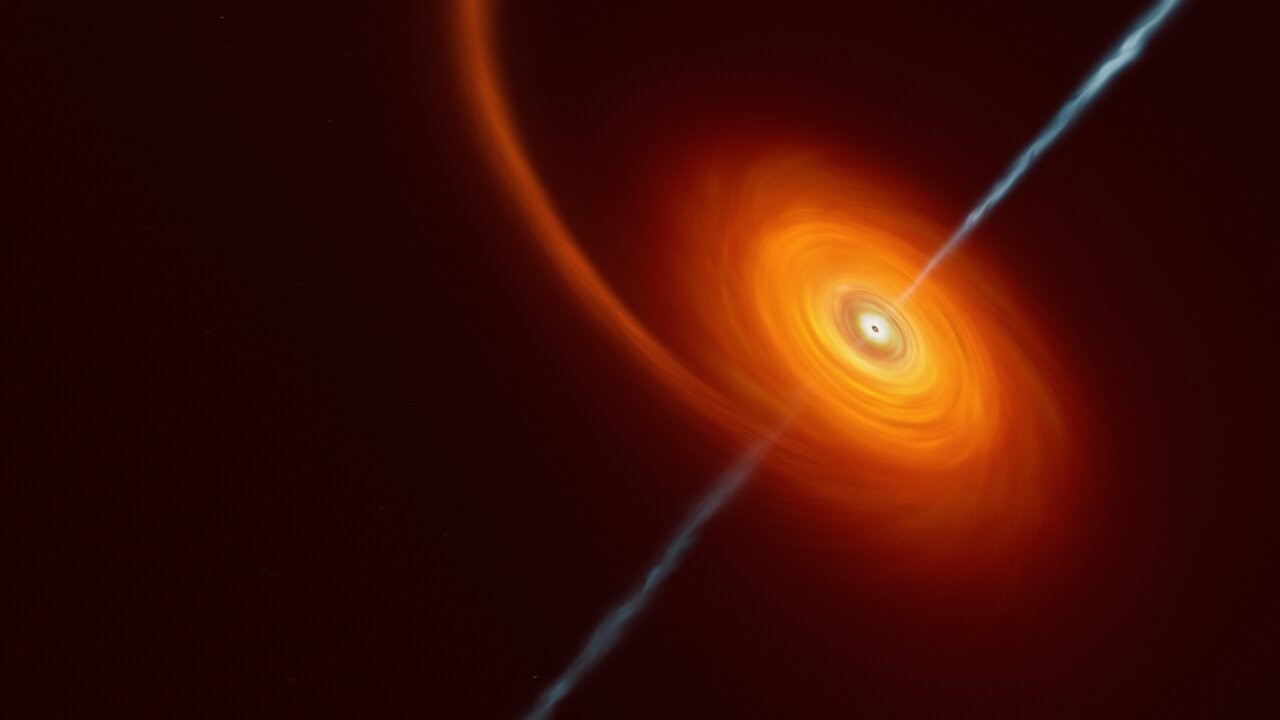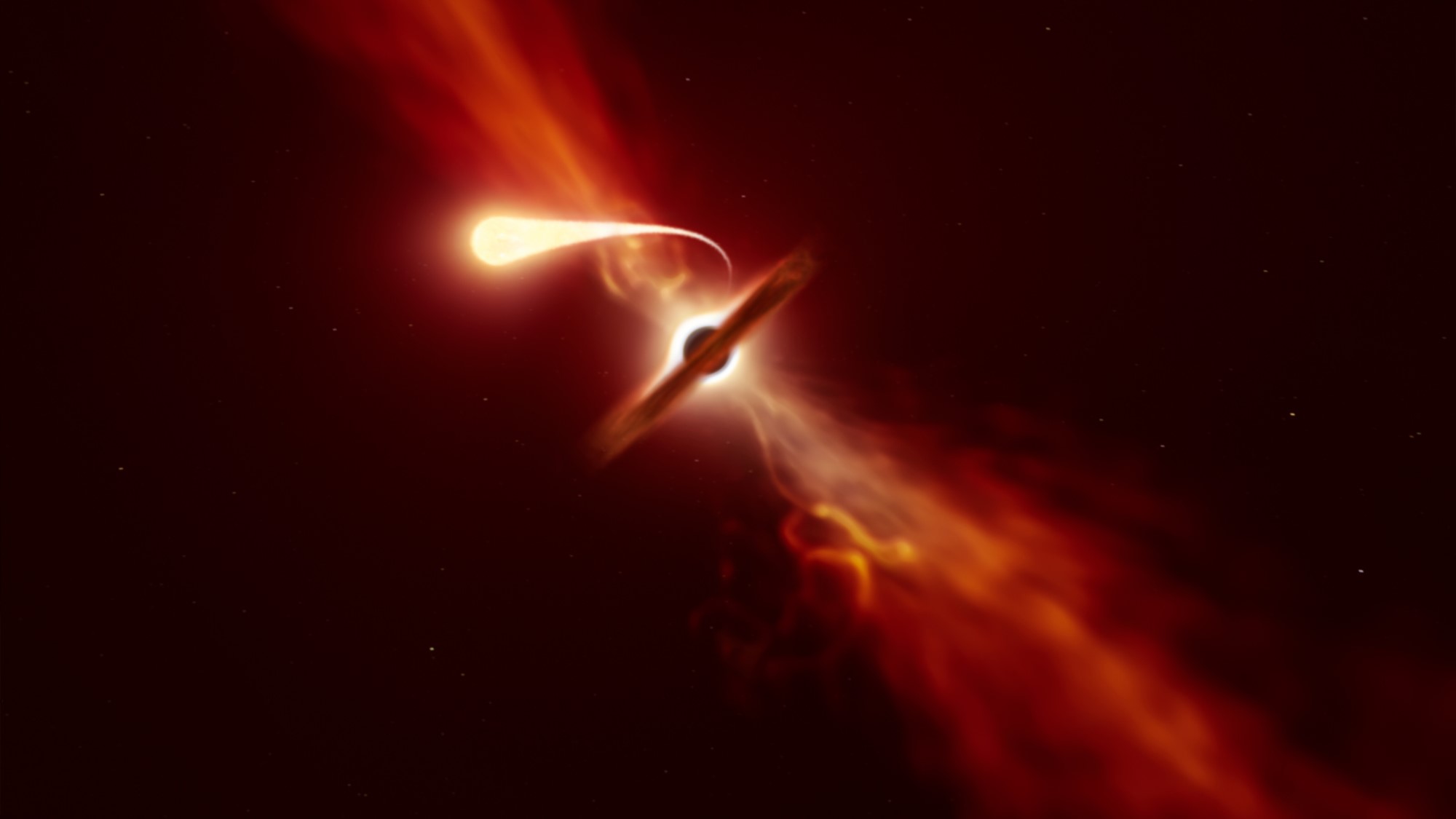Astronomers have made the most distant observation of a black hole ripping apart a star and feasting upon it, thanks to a jet of stellar “leftovers” blasted directly toward Earth.
Because the jet is directed straight at Earth, the violent destruction of the star by this black hole, which astronomers call a tidal disruption event (TDE), was observable in visible light. The discovery could therefore signal a new way to observe such extreme events that are usually only detected in high-energy light, like gamma-rays and X-rays.
TDEs occur when stars wander too close to black holes. The black hole tears apart the star with incredibly powerful tidal forces created by its gravitational influence. In around 1% of TDEs, the black hole also blasts out jets of plasma and radiation from its poles.
“We have only seen a handful of these jetted-TDEs and they remain very exotic and poorly understood events,” Nial Tanvir, an astronomer at the University of Leicester in the U.K. and co-author on the new research, said in a statement (opens in new tab) from the European Southern Observatory (ESO), which operates some of the telescopes used in the research. “Astronomers are thus constantly hunting for these extreme events to understand how the jets are actually created and why such a small fraction of TDEs produce them.”
Related: 8 ways we know that black holes really do exist
The discovery of this TDE, dubbed AT2022cmc, came in February, when a survey telescope, the Zwicky Transient Facility (ZTF) in California, sent out an alert about an unusual source of visible light, which ESO’s Very Large Telescope (VLT) in the Atacama Desert region of Northern Chile then jumped to examine. It’s a common dynamic for astronomers: Survey telescopes like ZTF pan across the sky for signs of short-lived and extreme events, which more focused telescopes like the VLT can follow up on, observing in greater detail.
AT2022cmc first resembled a gamma-ray burst (GRB), the most powerful source of electromagnetic radiation in the known universe, the origins of which remain unknown. The opportunity to observe one of these rare and mysterious blasts of light prompted astronomers to train a variety of telescopes on AT2022cmc, including the VLT, which studied the event using its X-shooter spectrograph instrument. All told, 21 telescopes observed AT2022cmc in various wavelengths of light, including the Hubble Space Telescope and the Neutron Star Interior Composition Explorer (NICER) X-ray instrument aboard the International Space Station.
The wealth of data revealed two strange observations. First, the source of AT2022cmc was located at an unprecedented distance from Earth and the light began its journey when the 13.8 billion-year-old universe was just one-third of its current age. Second, the event wasn’t a gamma-ray burst.
“Things looked pretty normal the first three days,” Dheeraj Pasham, an astrophysicist at the Massachusetts Institute of Technology who was first author on one of the studies, said in a statement (opens in new tab).
“Then we looked at it with an X-ray telescope, and what we found was, the source was too bright,” he said of the NICER observations, noting that the signal remained 100 times more powerful than the afterglow from any gamma-ray burst seen to date. “It was something extraordinary.”

Around the globe, a total of 21 telescopes observed AT2022cmc in various wavelengths of light, from high-energy gamma-rays to low-energy radio waves. Then, astronomers could compare this data to observations of other violent events, like collapsing stars and the powerful cosmic explosions called kilonovas.
The only scenario that matched the light profile recorded by these telescopes was the rare case when a TDE jet — containing matter moving at 99.99% the speed if light — points right at Earth.
“Because the relativistic jet is pointing at us, it makes the event much brighter than it would otherwise appear, and visible over a broader span of the electromagnetic spectrum,” Giorgos Leloudas, an astronomer at DTU Space in Denmark and co-author on the new research, said in the ESO statement.

That said, the jet is still pretty bright — so bright that astronomers calculated the black hole is eating about half the sun’s worth of mass each year, Pasham said, adding that the volume suggests the researchers spotted the event early on. “A lot of this tidal disruption happens early on, and we were able to catch this event right at the beginning, within one week of the black hole starting to feed on the star.”
The distance of this TDE from Earth isn’t the only record-breaking aspect of AT2022cmc. Previously, jetted TDEs such as this one had only been spotted in high-energy types of radiation like gamma-rays and X-rays: This is the first time one of these violent star-killing events has been seen in optical light.
As such, the observation of AT2022cmc in optical light could open up a whole new way of detecting these jet-firing TDEs across the vastness of space, thus allowing for the deeper study of these rare events and the black holes that trigger them.
The research is described in two (opens in new tab) papers (opens in new tab) published on Wednesday (Nov. 30), in the journal Nature.
Follow us on Twitter @Spacedotcom or on Facebook.

